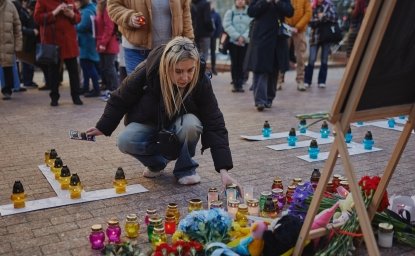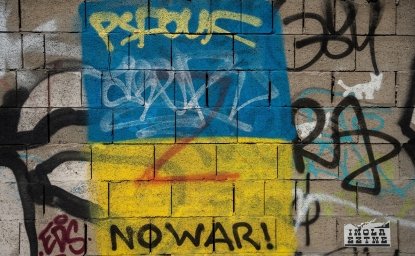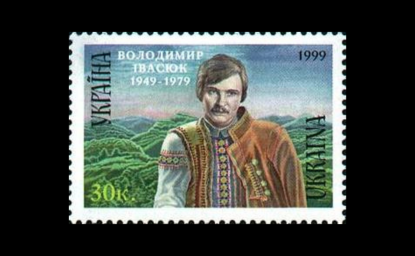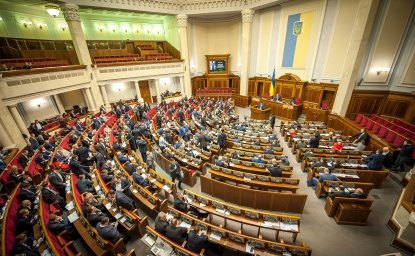
A blog of the Kennan Institute
Nikita Kadan’s exhibit “The Ray Penetrates the Soil” at Kyiv’s Voloshyn Gallery in March might seem, at first hearing, to have been a paradigmatic Ukrainian art show. As classic a Ukrainian theme as sun and soil might appear, however, Kadan’s work was startlingly new. Consisting of several highly refined metal installations of stark simplicity, the artist’s work simultaneously projected a traditional theme and stunningly contemporary abstraction.
Kadan’s show, as all his work, combined reassuring comfort with unexpected abstraction. A child of a newly independent Ukraine, the artist, now 40-something, has exhibited at leading museums, fairs, and galleries around the world for over two decades. After graduating from the National Academy of Fine Art in Kyiv in 2007, Kadan began working with historians, architects, and human rights activists to establish the noteworthy RER (Revolutionary Experimental Space) Group during the 2004 Orange Revolution. He continued working with artists of his generation to define what it means to be free and to be Ukrainian in the 21st century. His appearance at the 2015 Venice Biennale cemented his standing as one of his generation’s leading artists worldwide, not just in Ukraine.
This year’s exhibit at the Voloshyn Gallery builds on his earlier wartime series “The Shadow on the Ground,” which he developed while working in a bomb shelter. Drawing on what Kadan calls “poetics of visible evidence,” that project emerged around the theme of Ukrainian black arable land. Seeing the missile left by a Russian missile hitting Shevchenko Park in Kyiv prompted his probe of Ukraine’s fate through the image of its land. His astonishingly simple abstract sculptures, charcoal drawings, and paintings in this spring’s exhibit captured the ways in which the war’s intrusions leave lasting wounds on the landscape, a landscape deeply connected to an injured Ukraine.
His work shares a mission with the gallery to showcase Ukraine’s most contemporary art. Founded in 2016, shortly after Forbes Magazine placed founders Max and Julia Voloshyn on its “30 Under 30” list of people to watch, the gallery has sought the integration of Ukrainian art with global cultural trends. Partnering with institutions and contemporary art fairs around the world, the Voloshyn Gallery has become a bridge between the Ukrainian and global contemporary artistic communities. For nearly a decade, the Voloshyns have brought the works of scores of leading contemporary Ukrainian artists to the attention of the international art world.
The Voloshyns closed their cutting-edge gallery, located in the basement of a century-old building on Tereshchenkivska Street overlooking Kyiv’s Shevchenko Park, when the Russians launched their full-scale invasion. Within the year, they decamped for Miami’s vibrant Wynwood district, bringing new Ukrainian works to the trendy South Florida art scene. As the couple told the German website Art Cologne, “Ukraine has a strong artistic voice, and for this reason, our mission is to keep moving. We want to make this voice be heard and welcomed in the world community.”
They reopened their Kyiv gallery in mid-2023, engaging in the return of Kyiv’s own vivid art scene as the Ukrainian capital’s arts community reopened, despite the hardships of war. The intent is to pick up where the gallery had left off.
In a 2022 interview with ArtForum’s David Velasco, Kadan explained the need for continuity. “In a peaceful, or a relatively peaceful time,” he explained, “I was not so interested in this aspect of just being Ukrainian… If we postpone criticality for all of this period, we will turn to like basically an undemocratic state, you know? … No, we cannot postpone criticality, but we have to be responsible and make a proper practical solution.” Kadan does so through his art. It’s an artistic expression that remains rooted in Ukraine’s black soil while simultaneously drawing on the most cutting-edge forms of contemporary artistic expression.
The opinions expressed in this article are those solely of the author and do not reflect the views of the Kennan Institute.
Author

Former Wilson Center Vice President for Programs (2014-2017); Director of the Comparative Urban Studies Program/Urban Sustainability Laboratory (1992-2017); Director of the Kennan Institute for Advanced Russian Studies (1989-2012) and Director of the Program on Global Sustainability and Resilience (2012-2014)

Kennan Institute
After more than 50 years as a vital part of the Wilson Center legacy, the Kennan Institute has become an independent think tank. You can find the current website for the Kennan Institute at kennaninstitute.org. Please look for future announcements about partnership activities between the Wilson Center and the Kennan Institute at Wilson Center Press Room. The Kennan Institute is the premier US center for advanced research on Eurasia and the oldest and largest regional program at the Woodrow Wilson International Center for Scholars. The Kennan Institute is committed to improving American understanding of Russia, Ukraine, Central Asia, the South Caucasus, and the surrounding region through research and exchange. Read more

Explore More in Focus Ukraine
Browse Focus Ukraine
Talking to the Dead to Heal the Living

Ukrainian Issue in Polish Elections


